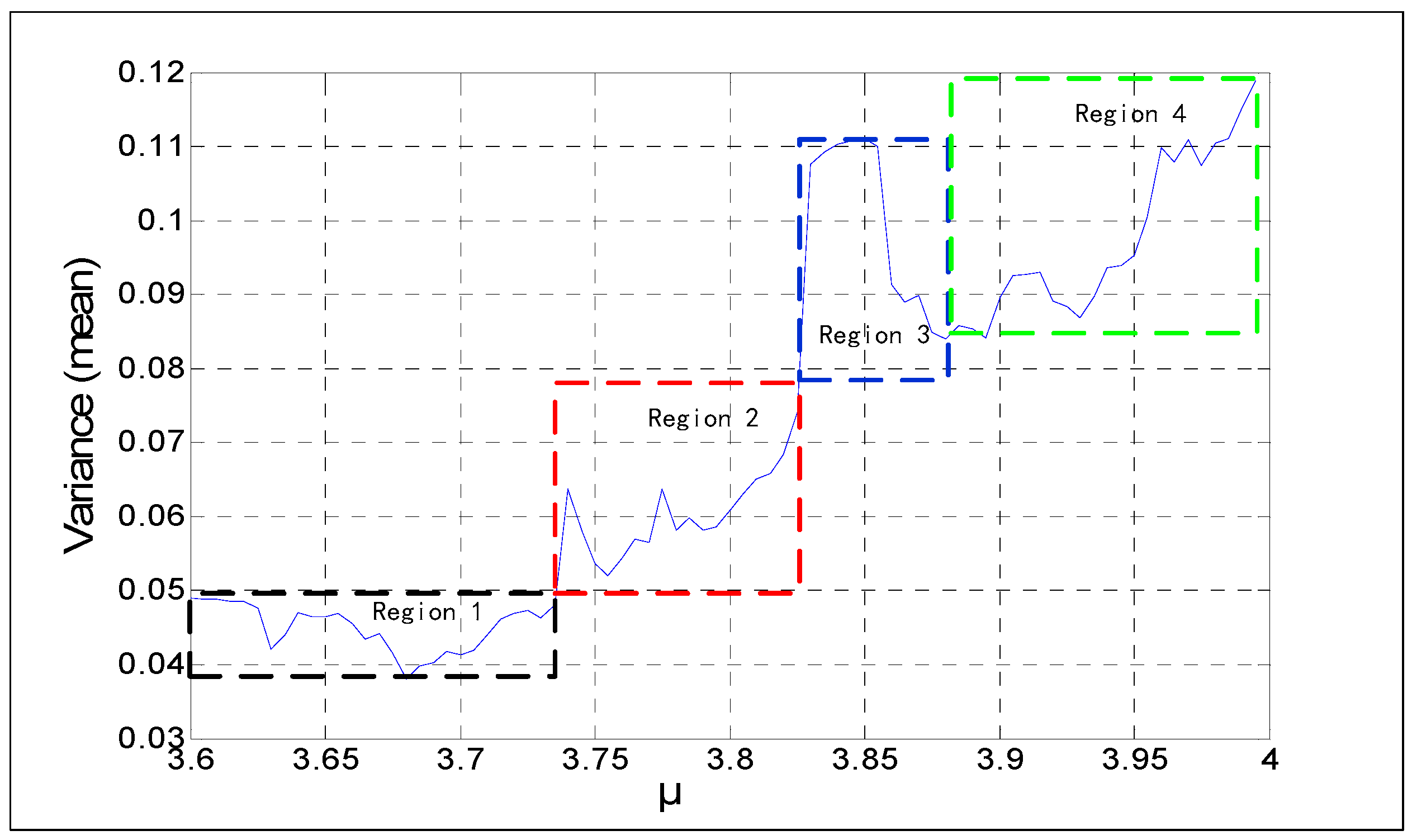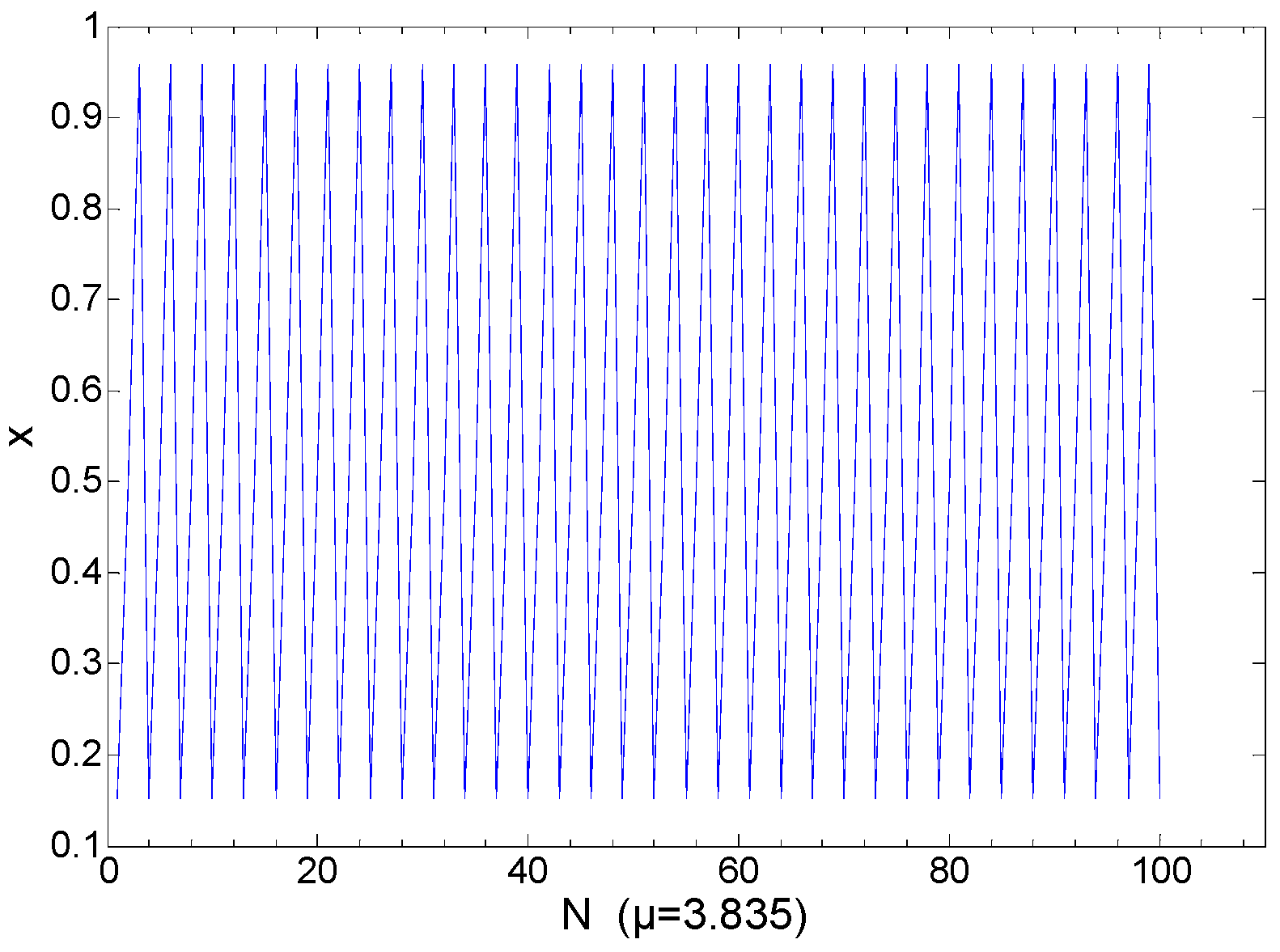Research about the Characteristics of Chaotic Systems Based on Multi-Scale Entropy
Abstract
:1. Introduction
2. Features of Logistic Chaotic System
- If μ (0,1), the system stability value is 0;
- If μ (1,3), the system has two stable points x = 0 and x = 1 − 1/μ;
- If μ (3,3.499), the system has two periodic points, that is,
- If μ (3.499,3.544), the system has four periodic points;
- If μ (3.544,3.564), the system has eight periods.
3. Multi-Scale Entropy (MSE) of Time Sequence
- Set x1, x2, …, xL as a discrete-time sequence, including L points. Conduct coarse-graining conversion on the original time series, and divide the original time series into non-overlapping windows with a length of τ. Calculate the average value of each window, and obtain the new coarse-graining time series. Each new data point is derived from Equation (2), as follows:In Equation (2), τ is the scale factor. Each coarse-graining time series has a length of L/τ. Equation (3) and Equation (4) are the methods for computing the coarse-graining of the time series, in which τ = 2 and τ = 3. When τ is 1, it is the original series.
- Then, for a different τ, compute the SampEnon coarse-graining time series. SampEn originates from ApEn. However, the calculation of the approximate entropy also involves comparing its own data, which may induce certain errors. In order to reduce the errors, in the literature [28], for the given threshold value r, Richman calculated the ratio between the number of and the total distance N − m, denoted as .
- Calculate the average of all points, as follows:
- Add dimension m by 1, repeat procedures 2–3, and obtain of scale τ, then recalculate the average .In the actual calculation, use SampEn, as follows:MSE is as follows:
4. Macroscopic Characteristics of Logistic Chaotic Sequences
- The 3D graph in Figure 3a appears smoother than Figure 1a and Figure 2a. In the same statistic conditions and threshold conditions, time series with longer lengths indicate a more stable statistical probability and lower degrees of dispersion. Hence, the length of the sequences has an impact on MSE.
- In Figure 1c,d, the MSE value changes significantly. Because the length of the sequence is reduced by half during the process of coarse-graining. For the MSE method, although the number of points were reduced, the coarse-graining time series is not a subset of the original time series. On the contrary, the series includes all of the information about the original time series. Therefore, the error caused by the reduction of length of the coarse-graining time series is likely to be lower than that caused by the subset of the original time series. That is to say, coarse-graining time series on large time scales is likely more irregular (and is assigned a higher MSE value) than the original time series.
- Figure 2c,d indicate the variance and coefficient variables of a sequence at N = 2000. The mean value of the variances, excluding the maximum and minimum values, is about 0.0012. There are 23 coefficient of variable (CV) that exceed 5%, including the value near the parameter μ = 3.57, and the sequence is not in a completely chaotic status. Figure 3c,d indicate the variances and coefficient variables of sequences at N = 5000. The maximum variance is . The remaining points are not more than , other than the points near . The range of coefficient variables is from 1% to 3%. In other words, the changes of the initial value do not change the MSE values of the series. Not all chaotic characters of the logistic system have dependency on the initial value. For this, it is possible to make a reasonable estimation and prediction on a chaotic system from macroscopic perspectives.
5. The Parameter Estimation of Chaotic Sequences
5.1. The Parameter Estimation of the Logistic Chaotic Sequence
5.2. The Parameter Estimated of the Tent Chaotic Sequence
6. Conclusions
Author Contributions
Funding
Conflicts of Interest
References
- Huang, L.L.; Yin, Q.T. A chaos synchronization secure communication system based on output control. J. Electron. Inf. Technol. 2009, 31, 2402–2405. [Google Scholar] [CrossRef]
- Feigenbaum, M.J. Quantitative universality for a class of nonlinear transformations. J. Stat. Phys. 1978, 25–52. [Google Scholar] [CrossRef]
- Tang, J.S.; Ouyang, K.J. Controlling the period-doubling bifurcation of logistic model. Acta Phys. Sin. 2006, 55, 4437–4441. [Google Scholar] [CrossRef]
- Yang, L.J. Effects of time delay on transition rate of state in an increasing process of logistic system. Acta Phys. Sin. 2011, 60, 67–70. [Google Scholar] [CrossRef]
- Stein, R.R.; Isambert, H. Logistic map analysis of biomolecular network evolution. Phys. Rev. E 2011, 84, 051904. [Google Scholar] [CrossRef] [PubMed]
- Wang, X.Y.; Liang, Q.Y. Reverse bifurcation and fractal of the compound logistic map. Commun. Nonlinear Sci. Numer. Simul. 2008, 13, 913–927. [Google Scholar] [CrossRef]
- Wang, X.Y.; Luo, C. Bifurcation and fractal of the coupled logistic map. Int. J. Mod. Phys. B 2008, 22, 4275–4290. [Google Scholar] [CrossRef]
- Wang, X.Y.; Liang, Q.Y.; Meng, J. Chaos and fractals in C–K map. Int. J. Mod. Phys. C 2008, 19, 1389–1409. [Google Scholar] [CrossRef]
- Antonio, P. Quantifying the dynamical complexity of chaotic time series. Phys. Rev. Lett. 2017, 118, 144101. [Google Scholar] [CrossRef]
- He, S.; Sun, K.; Wang, H.H. Multivariate permutation entropy and its application for complexity analysis of chaotic systems. Physica A 2016, 461, 812–823. [Google Scholar] [CrossRef]
- Zhang, Y.; Shang, P. Multivariate multiscale distribution entropy of financial time series. Physica A 2019, 515, 72–80. [Google Scholar] [CrossRef]
- Serinaldi, F.; Zunino, L.; Rosso, O.A. Complexity–entropy analysis of daily stream flow time series in the continental United States. Stoch. Environ. Res. Risk Assess. 2014, 28, 1685–1708. [Google Scholar] [CrossRef]
- Tan, L.; Qi, W.F.; Xu, H. Asymptotic analysis on the normalized k-error linear complexity of binary sequences. Des. Codes Cryptogr. 2012, 62, 313–321. [Google Scholar] [CrossRef]
- Luo, C.W. The mathematical description of uniformity and its relationship with chaos. Chin. Phys. Soc. 2009, 58, 3788–3792. [Google Scholar] [CrossRef]
- Wang, X.Y.; Li, Z.M. A stream/block combination image encryption algorithm using logistic matrix to scramble. IJNSNS 2019, 20, 167–177. [Google Scholar] [CrossRef]
- Elsadany, A.A.; Yousef, A.M.; Elsonbaty, A. Further analytical bifurcation analysis and applications of coupled logistic maps. Appl. Math. Comput. 2018, 338, 314–336. [Google Scholar] [CrossRef]
- Amigó, J.M.; Kocarev, L.; Szczepanski, J. Order patterns and chaos. Phys. Lett. A 2006, 355, 27–31. [Google Scholar] [CrossRef]
- Bruce, S. Applied Cryptography, 2nd ed.; China Machine Press: Beijing, China, 2014; pp. 283–305. ISBN 9787111445333. [Google Scholar]
- Fan, C.L.; Ding, Q. A Novel Image Encryption Scheme Based on Self-Synchronous Chaotic Stream Cipher and Wavelet Transform. Entropy 2018, 20, 445. [Google Scholar] [CrossRef]
- Wang, C.F.; Fan, C.L.; Ding, Q. Constructing discrete chaotic systems with positive Lyapunov exponents. Int. J. Bifurc. Chaos 2018, 28, 1850084. [Google Scholar] [CrossRef]
- Pincus, S. Approximate entropy (ApEn) as a complexity measure. Chaos 1995, 5, 110–117. [Google Scholar] [CrossRef]
- Richman, J.S.; Moorman, J.R. Physiological time-series analysis using approximate entropy and sample entropy. Am. J. Physiol.-Heart Circ. Physiol. 2000, 278, H2039–H2049. [Google Scholar] [CrossRef] [PubMed] [Green Version]
- Zhang, Y.C. Complexity and 1/f noise. A phase space approach. J. Phys. I 1991, 1, 971–977. [Google Scholar] [CrossRef]
- Fogedby, H.C. On the phase space approach to complexity. J. Stat. Phys 1992, 69, 411–425. [Google Scholar] [CrossRef]
- Costa, M.; Goldberger, A.L.; Peng, C.K. Multiscale entropy analysis of complex physiologic time series. Phys. Rev. Lett. 2002, 89, 068102. [Google Scholar] [CrossRef] [PubMed]
- Costa, M.; Goldberger, A.L.; Peng, C.K. Multiscale entropy analysis of biological signals. Phys. Rev. E. 2005, 71, 021906. [Google Scholar] [CrossRef] [PubMed]
- Thuraisingham, R.A.; Gottwald, G.A. On multiscale entropy analysis for physiological data. Physica A 2006, 366, 323–332. [Google Scholar] [CrossRef]
- Costa, M.; Peng, C.K.; Goldberger, A.L.; Hausdorff, J.M. Multiscale entropy analysis of human gait dynamics. Physica A 2003, 330, 53–60. [Google Scholar] [CrossRef]
- Kohda, T.; Tsuneda, A. Statistics of chaotic binary sequences. IEEE Trans. Inf. Theory 1997, 43, 104–112. [Google Scholar] [CrossRef]
- Dubois, D.M. Recurrent Generation of Verhulst chaos maps at any order and their stabilization diagram by anticipative control. In The Logistic Map and the Route to Chaos; Ausloos, M., Dirickx, M., Eds.; Springer: Berlin, Germany, 2006; pp. 3–11. ISBN 978-3-540-28366-9. [Google Scholar]











| Region | μ | Variance |
|---|---|---|
| Section 1 | 3.600–3.735 | 0.03805–0.04899 |
| Section 2 | 3.735–3.825 | 0.04899–0.07406 |
| Section 3 | 3.825–3.865 | 0.07406–0.11110 |
| Section 4 | 3.865–3.995 | 0.08394–0.11880 |
| Region | μ | Variance |
|---|---|---|
| 1 | 1.00–1.19 | 2.451 × 10−5–0.00605 |
| 2 | 1.20–1.39 | 0.00657–0.01464 |
| 3 | 1.40–1.59 | 0.01476–0.02533 |
| 4 | 1.60–1.79 | 0.02652–0.04637 |
| 5 | 1.80–1.99 | 0.04774–0.07934 |
© 2019 by the authors. Licensee MDPI, Basel, Switzerland. This article is an open access article distributed under the terms and conditions of the Creative Commons Attribution (CC BY) license (http://creativecommons.org/licenses/by/4.0/).
Share and Cite
Liu, C.; Ding, L.; Ding, Q. Research about the Characteristics of Chaotic Systems Based on Multi-Scale Entropy. Entropy 2019, 21, 663. https://doi.org/10.3390/e21070663
Liu C, Ding L, Ding Q. Research about the Characteristics of Chaotic Systems Based on Multi-Scale Entropy. Entropy. 2019; 21(7):663. https://doi.org/10.3390/e21070663
Chicago/Turabian StyleLiu, Chunyuan, Lina Ding, and Qun Ding. 2019. "Research about the Characteristics of Chaotic Systems Based on Multi-Scale Entropy" Entropy 21, no. 7: 663. https://doi.org/10.3390/e21070663
APA StyleLiu, C., Ding, L., & Ding, Q. (2019). Research about the Characteristics of Chaotic Systems Based on Multi-Scale Entropy. Entropy, 21(7), 663. https://doi.org/10.3390/e21070663





